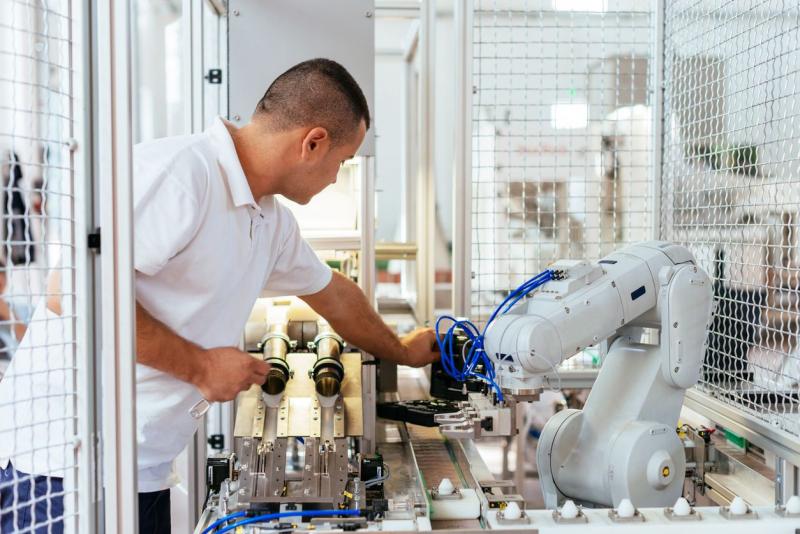Why the Smart Factory is Paying Dividends for Early Adapters
Smart factories and increased automation are providing manufacturers with a modern solution so that they can drive their innovations faster, whether to reduce waste, lower energy use and/or address worker shortages. The fourth industrial revolution, or Industry 4.0, is all about automated systems that can connect to each other and exchange data to accomplish such needs and goals. Here’s how and why early adapters are already seeing the benefits of this new world order in manufacturing.

What is a smart factory?
The Internet of Things has brought many a new innovation the world of consumer automation. Similarly, the Industrial Internet of Things, or IIoT, has changed the way modern factories can operate. A smart factory is one in which a variety of seemingly unrelated machines and equipment are able to connect and communicate with each other, self-optimize based on learnings, and automate any number of tasks.
Cloud computing and sophisticated digital sensors are at the heart of Industry 4.0 and the modern smart factory. By placing sensors throughout a production or assembly line, factory processes can be monitored 24/7 in order to ensure that all connected pieces are operating at their most efficient, optimal capacity. Often, these sensors feature warning capabilities in order to alert the relevant automation technician that maintenance must be undertaken in order to prevent more serious issues from occurring at a later date and time.
What are the benefits?
While entering into the world of smart manufacturing may seem daunting at first, getting past the initial hurdle of integrating factory equipment has proven to be a winning move for many companies. Big names like Hewlett-Packard, Siemens, Whirlpool, Adidas and Ocado have already seen big wins by investing in smart technology.

1. Less waste
Predictions have reported that a number of industries may see doubled profits and margins in the coming years by putting smart technology into place. For instance, by having improved analytics and access to troves of data for every step of the manufacturing process, technicians can easily predict demand cycles and better manage their inventory levels, deliveries, and more. This can allow manufacturers to identify and reduce overall waste. This is both good for the planet and good for the wallet. On this note, IIoT can help companies significantly reduce their energy bills, which can often easily represent some of their largest regular expenses. Just like smart home thermostats can ensure that a washing machine only runs during off-peak hours, smart factories can leverage IIoT technology to provide energy-saving recommendations.

2. More insights
It isn’t called Big Data without a reason. Smart technology can provide immense amounts of data on everything from the temperature of a particular refrigerated truck on a Sunday afternoon at 2:17pm to the number of chocolate bars that passed a metal contaminant test four months ago. By collecting data on the seemingly mundane to the obviously crucial, smart technology can provide predictions, raw data and more to the appropriate parties who need to understand up-to-date performance metrics or make decisions regarding plant operations – whether the impact will be felt in the next hour or in the next year.
3. Seamless maintenance and less downtime
With smart technology providing status updates on all connected hardware and software, maintenance problems can be nipped in the bud early and often in order to ensure that smart factories run for as long as possible and as efficiently as possible without sacrificing health and safety or product quality. Some companies are already working on developing robots with self-correcting features capable of diagnosing their own issues and adjusting themselves in real time. By aiming for zero-downtime, such solutions could represent savings of several thousands of dollars per minute depending on the industry. Companies like General Motors (GM) have already reportedly avoided over 100 unexpected downtimes since 2014 when they launched ZDT (Zero Down Time Solution, a data analyzing software platform) in partnership with FANUC and Cisco.
4. Better products
Less downtime and reduced costs are great, but not if product quality suffers as a result. With smart factory technology, product quality actually tends to go up. Typically, quality issues often arise due to equipment that has been either incorrectly installed, calibrated or maintained. Unfortunately, it can be hard to identify issues at first glance without the all-seeing eyes and ears of IIoT. Thanks to constant monitoring, even if a product may seem visually acceptable, workers can be alerted if said product was handled by faulty machinery that may have resulted in, for instance, the production of lesser quality paint or improperly balanced salt to flour ratios.
Conclusion
Smart factories are increasingly becoming the norm as IIoT technology becomes more sophisticated and widely available across different industries and sectors. Many companies both large and small have already begun paving the way for Industry 4.0, and those who don’t innovate will be left behind. In these highly automated environments, technicians will be in high demand. Check out George Brown’s automation program for more information on our online courses in robotics to learn how you too can become a robotics technician and be a part of the next wave of industrial automation.
